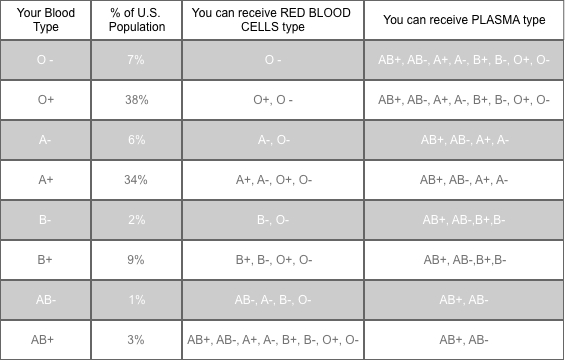There is no substitute for donated blood, it brings life and saves life. Each person has enough to safely donate which the body can then replenish. Blood is composed of various components and unique types and factors.
Blood is considered a medicine and therefore a treatment, which can be used in many ways:
- Help provide treatment for burn victims, individuals with blood-borne illnesses, and some cancers.
- Support major surgeries, scheduled or unplanned.
- A stabilizer during trauma and emergency situations.
ASBP is regulated by Food and Drug Administration guidelines to maintain the safety and quality of blood products. The program is held to the same standards and requirements as civilian collection agencies, and along with them, receive accreditation from the Association of Advancement of Blood and Biotherapies, a not-for-profit international transfusion medicine association.
Components
Whole blood is made from various components including blood plasma, platelets, white cells, and red cells. With modern medical technology, patients sometimes receive just a component they need instead of receiving a whole blood transfusion. One of the benefits of this treatment approach is that multiple patients can benefit from a single donation. And a reason why people site that one donation can save up to three lives, because of how a whole blood donation can be separated into components!

Whole blood (all components): Requires less processing than other components and is arguably more flexible as it can be broken down into its individual components. Medically, it is useful when a patient needs all blood components. For example, a patient may require whole blood after undergoing a major surgery or after a traumatic event.
Red Blood Cells: Carry oxygen to the rest of the body from the lungs. They also take carbon dioxide back to the lungs to be exhaled. They are used to treat patients with chronic anemia, some blood disorders including sickle cell disease, among other uses.
Platelets: The primary purpose of platelets is covering the blood vessels lining to prevent or stop bleeding. They are often needed during organ transplants, to heal certain cancers, and to treat patients with thrombocytopenia who have a shortage of platelets.
Plasma: The liquid that makes up our blood. The other blood components are suspended in plasma inside our body. It is often used for shock patients, burn patients, trauma patients, and for individuals with blood clotting issues.
Blood Type
There are four different blood groups: A, B, AB, and O. A person's blood group is distinguished by tiny markers known as antigens which cover the blood cell surface. Below is a simple breakdown of blood groups and antigens.
- Group A blood has A antigens
- Group B blood has B antigens
- Group AB blood has both A and B antigens
- Group O blood has neither A nor B antigens

Blood can be separated into three main components – red blood cells, platelets, and plasma. Depending on a person's blood group, their plasma can produce antibodies against foreign antigens. If a person receives RBCs that their plasma has created antibodies against, the new blood will be attacked, which could prove fatal.
In addition to A and B antigens, there is also an Rh antigen. A person's blood type is determined by the presence or absence of the Rh antigen. Individuals who have the antigen are known as Rh positive and individuals without it are known as Rh negative. The combination of an individual's blood group (A, B, AB, O) and the presence or absence of the Rh antigen (+ or -) determines an individual's blood type.
Individuals who are Rh negative can develop anti-Rh antibodies. If these antibodies are developed, they could attack Rh positive blood and cause a fatal reaction, therefore, Rh negative individuals cannot receive Rh positive blood.”

Blood Donation
Blood donors are greatly needed and are the heart of the military blood program. 40% of the U.S. population is eligible to give blood and yet only 3% of this population donate on a regular basis. The ASBP needs a constant flow of donations, and of all types, year-round, all to support the warfighter and their families. Our number one goal is to provide a safe and potent blood supply to our military community and beyond.
A whole blood or ‘typical’ donation only takes about ten minutes; however, there are steps that come before and after donation to keep donors healthy and the blood supply safe. In general, the entire blood donation process takes about 45 minutes to one hour. Actual times vary by site and the number of people donating that day.
It also depends on the type of donation made. Plasma, platelets or red cells can also be donated but require donating through a process called apheresis. Apheresis is the process of removing specific components of blood and returning the remaining components to the donor. Though the process takes about twice as long as a whole blood donation, it can be done more often than a whole blood donation.

To find out what the donation process is like, step-by-step, go to our Be A Donor page.